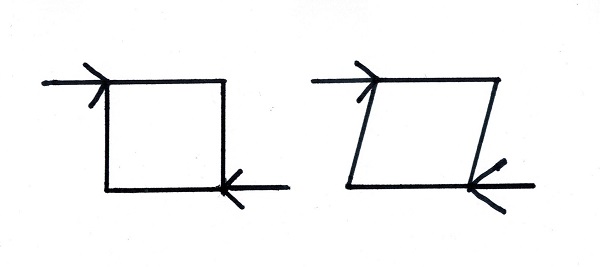Shear force
A shear force is a force applied along the surface, in opposition to an offset force acting in the opposite direction. This results in a shear strain. In simple terms, one part of the surface is pushed in one direction, while another part of the surface is pushed in the opposite direction.
This is different to compression, which occurs when the two opposing forces are pushing into each other at the same point (i.e. they are not offset), resulting in compressive stress.
When a structural member experiences failure by shear, two parts of it are pushed in different directions, for example, when a piece of paper is cut by scissors.
Large or high-rise buildings must be designed with shear walls to provide resistance to shear forces, which might otherwise push over parallel structural elements of a building, in what is known as racking. For more information, see Shear wall.
[edit] Related articles on Designing Buildings Wiki
- Bearing capacity.
- Bending moment.
- Biaxial bending.
- Building foundations.
- Concept structural design of buildings.
- Defects in construction.
- Lateral loads.
- Limit state design.
- Moment.
- Point of contraflexure.
- Racking.
- Settlement.
- Shear wall.
- Structural principles.
- The design of temporary structures and wind adjacent to tall buildings.
- Types of structural load.
- Wind comfort simulations.
Featured articles and news
International Electrician Day, 10 June 2025
Celebrating the role of electrical engineers from André-Marie Amperè, today and for the future.
New guide for clients launched at Houses of Parliament
'There has never been a more important time for clients to step up and ...ask the right questions'
The impact of recycled slate tiles
Innovation across the decades.
EPC changes for existing buildings
Changes and their context as the new RdSAP methodology comes into use from 15 June.
Skills England publishes Sector skills needs assessments
Priority areas relating to the built environment highlighted and described in brief.
BSRIA HVAC Market Watch - May 2025 Edition
Heat Pump Market Outlook: Policy, Performance & Refrigerant Trends for 2025–2028.
Committing to EDI in construction with CIOB
Built Environment professional bodies deepen commitment to EDI with two new signatories: CIAT and CICES.
Government Grenfell progress report at a glance
Line by line recomendation overview, with links to more details.
An engaging and lively review of his professional life.
Sustainable heating for listed buildings
A problem that needs to be approached intelligently.
50th Golden anniversary ECA Edmundson apprentice award
Deadline for entries has been extended to Friday 27 June, so don't miss out!
CIAT at the London Festival of Architecture
Designing for Everyone: Breaking Barriers in Inclusive Architecture.
Mixed reactions to apprenticeship and skills reform 2025
A 'welcome shift' for some and a 'backwards step' for others.
Licensing construction in the UK
As the latest report and proposal to licence builders reaches Parliament.
Building Safety Alliance golden thread guidance
Extensive excel checklist of information with guidance document freely accessible.
Fair Payment Code and other payment initiatives
For fair and late payments, need to work together to add value.
Pre-planning delivery programmes and delay penalties
Proposed for housebuilders in government reform: Speeding Up Build Out.
High street health: converting a building for healthcare uses
The benefits of health centres acting as new anchor sites in the high street.


























Comments